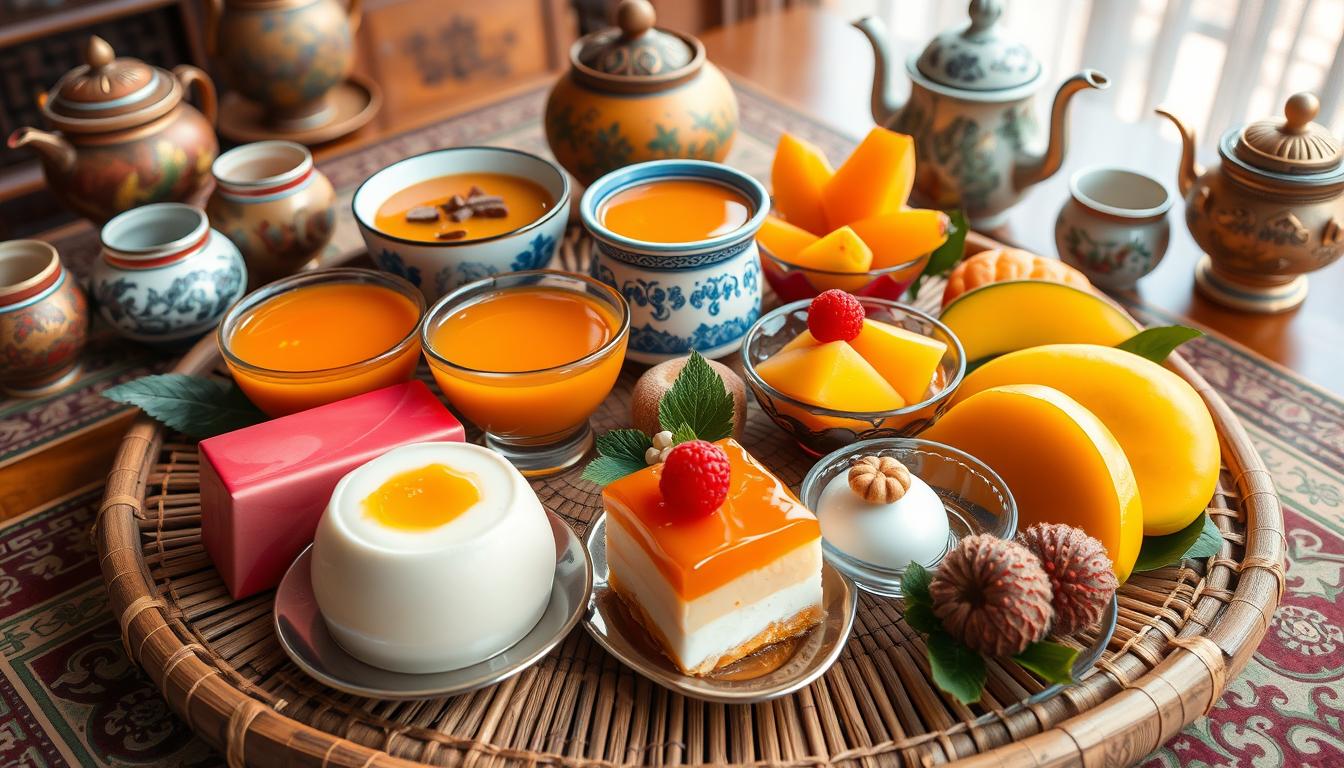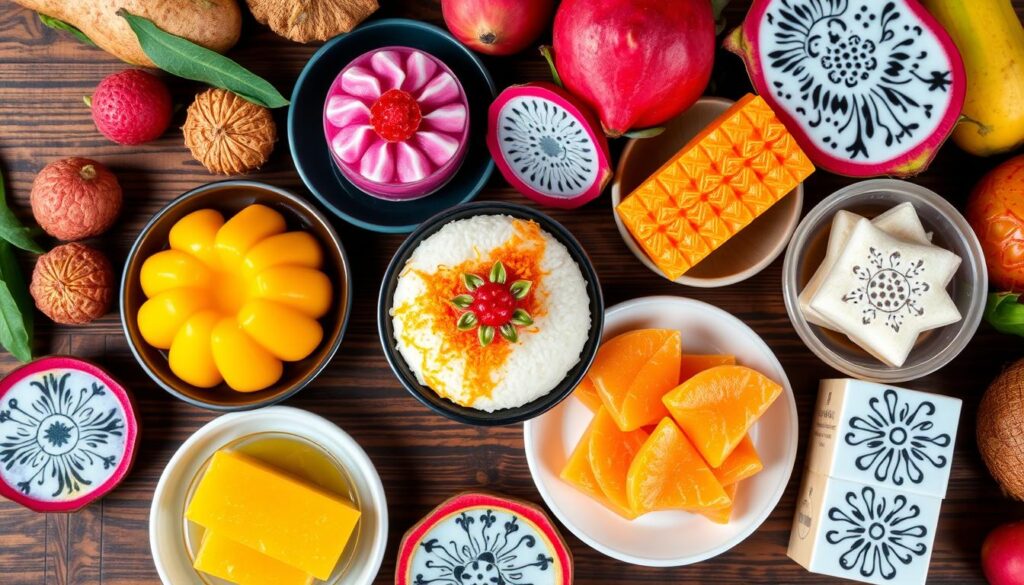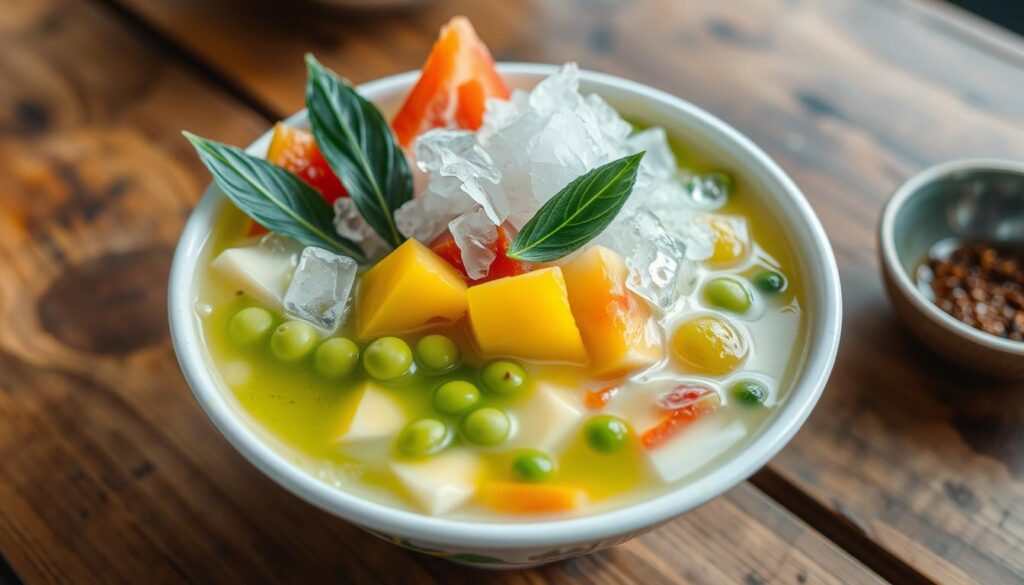Discover Authentic Vietnamese Desserts: Sweet Asian Treats
The first time I tasted a Vietnamese dessert, it was like finding a hidden treasure. The flavors were delicate, the textures rich, and the stories behind each bite were fascinating. It changed how I saw traditional Vietnamese sweets. Vietnamese desserts are a colorful celebration of taste. They mix coconut milk, sticky rice, and tropical fruits in amazing ways. These treats are more than just sweet; they open a window into Vietnam’s rich food culture.
From creamy chè to complex banh, Vietnamese desserts are incredibly diverse. Each region adds its own special touch. This makes the dessert scene as varied as Vietnam itself.
Vietnamese desserts are not just sweet. They balance flavors perfectly. They use herbal notes from pandan leaves, creamy coconut milk, and sweet and salty mixes. These elements make the desserts truly special.
If you love trying new foods or just want to try something different, Vietnamese desserts are a must. They offer a journey through taste, tradition, and pure deliciousness.
What are Traditional Vietnamese Desserts?
Vietnamese sweets are a journey of flavors and traditions. They mix Asian cuisines, creating unique desserts. These treats excite our taste buds and share stories of heritage.
Exploring Vietnamese desserts is a sweet adventure. They are found in street markets and family kitchens. These treats show Vietnam’s rich culinary creativity.
Overview of Vietnamese Desserts
Vietnamese desserts stand out with their special ingredients and ways of making them. They often include:
- Coconut milk
- Sticky rice
- Tropical fruits
- Unique herbal infusions
Popular Ingredients in Vietnamese Sweets
The base of banh cam and other Vietnamese sweets often has:
| Ingredient | Common Use |
|---|---|
| Mung Beans | Filling for pastries and sweet soups |
| Coconut Milk | Base for creamy desserts |
| Tapioca Pearls | Adding texture to dessert soups |
Cultural Significance of Sweets
Vietnamese desserts are more than treats. They are cultural expressions. Each sweet shares stories of traditions, family, and history. They are key in Vietnamese social life, from Lunar New Year to street snacks.
Desserts in Vietnam are not just about taste, but about connecting people and preserving culinary heritage.
From banh cam to coconut jellies, Vietnamese sweets are a flavorful journey. They blend tradition and innovation beautifully.
The Most Popular Vietnamese Desserts You Must Try
Vietnamese cuisine is a world of sweet delights. It offers creamy custards and refreshing dessert soups. These desserts show the country’s creativity and cultural depth.
Che: A Versatile Dessert Soup
Che is a standout in Vietnamese desserts. It comes in many flavors, loved by both locals and visitors. You can enjoy che hot or cold, with a mix of ingredients:
- Colorful beans
- Chewy tapioca pearls
- Fresh tropical fruits
- Coconut cream
Banh Flan: Vietnamese Caramel Custard Delight
Banh flan is Vietnam’s take on French crème caramel. It has a smooth texture and a caramel topping that’s irresistible. Served chilled, it’s a perfect mix of sweet and creamy.
“A spoonful of banh flan is like a journey through Vietnamese culinary elegance.” – Local Food Critic
Sticky Rice Desserts: A Cultural Staple
Sticky rice desserts are a big part of Vietnamese food. Known as xoi, they have different toppings that make them special. You might find them with:
- Mung beans
- Ripe mango
- Coconut shavings
- Roasted peanuts
These desserts tell stories of tradition and innovation. Trying che, banh flan, or sticky rice desserts is a sweet adventure.
Variations of Che: Exploring Dessert Soups
Vietnamese dessert soups, known as che, are a vibrant part of the country’s culinary tradition. They show the rich flavors and diverse ingredients of Vietnamese cuisine. These treats give a unique look into Vietnam’s culinary heritage.
Vietnam has many che variations that excite the taste buds. These desserts can be found in street markets and home kitchens. They show how versatile Vietnamese dessert soups can be.
Che Ba Mau (Three-Color Dessert)
Che Ba Mau is a feast for the eyes and taste buds. It combines:
- Red beans
- Yellow mung beans
- Green pandan jelly
- Coconut milk
- Crushed ice
Che Xoai (Mango Dessert)
Che Xoai is a refreshing twist for tropical fruit fans. It uses fresh mangoes as a base. This dessert celebrates the sweet, vibrant flavors of Southeast Asian produce.
Che Troi Nuoc (Glutinous Rice Balls in Syrup)
This beloved che variation has glutinous rice balls filled with mung bean paste. They are served in a warm ginger syrup. It’s a favorite during winter, bringing comfort and sweetness.
“Che represents more than just a dessert – it’s a culinary journey through Vietnam’s diverse flavor landscapes.”
| Che Variation | Key Ingredients | Typical Serving Temperature |
|---|---|---|
| Che Ba Mau | Beans, Jelly, Coconut Milk | Cold |
| Che Xoai | Mango, Coconut Milk | Cold |
| Che Troi Nuoc | Glutinous Rice, Mung Bean, Ginger Syrup | Hot |
Exploring street markets in Hanoi or making these treats at home, che variations offer a sweet look into Vietnam’s culinary traditions.
Banh: Vietnamese Cakes and Their Unique Flavors
Vietnamese cakes, known as banh, are a delightful part of Vietnamese cuisine. They show the creativity and cultural richness of Vietnam’s baking. These treats are both sweet and savory.
Exploring Vietnamese cakes, you’ll find a wide range of textures and flavors. Each banh has its own story, reflecting regional traditions and local ingredients.
Banh Mi: More Than Just a Sandwich
Banh mi is known as a popular sandwich, but it’s also a delicious salted egg yolk cake. It combines sweet and savory tastes, making it a memorable experience.
- Unique combination of sweet and salty tastes
- Made with rich egg yolk ingredients
- Popular in southern Vietnamese cuisine
Banh Chung: A Festive Square Sticky Rice Cake
Banh chung is a traditional Vietnamese cake tied to Tet celebrations. It’s a square-shaped sticky rice cake that symbolizes family unity and respect for ancestors.
“Banh chung is not just a cake, but a story of Vietnamese tradition wrapped in banana leaves.”
Banh Da Lon: The Layered Delicacy
Banh da lon showcases Vietnamese cake-making artistry. It’s made with tapioca starch, rice flour, mung beans, and coconut milk. This mix creates a unique texture and flavor.
| Ingredient | Role in Cake |
|---|---|
| Tapioca Starch | Provides chewy texture |
| Rice Flour | Adds lightness |
| Mung Beans | Creates subtle sweetness |
| Coconut Milk | Enhances rich flavor |
Exploring these Vietnamese cakes opens a world of culinary creativity. Each banh is a piece of Vietnam’s rich gastronomic landscape.
Seasonal Vietnamese Desserts to Enjoy
Vietnamese cuisine celebrates the changing seasons with its delightful desserts. Each season brings unique flavors and traditional treats. These desserts capture the essence of Vietnamese culinary culture.
Tet Cakes: Lunar New Year Celebrations
During Tet, the Vietnamese Lunar New Year, desserts are the main attraction. Tet cakes are at the heart of family gatherings and celebrations. Banh Chung, a traditional square sticky rice cake, symbolizes prosperity and family unity.
- Candied fruits (Mut)
- Traditional sticky rice specialties
- Festive sweet treats
Summer Fruit Desserts: Tropical Delights
Summer brings vibrant fruit desserts that refresh and delight. Hoa Qua Dam is a colorful mix of tropical fruits in creamy coconut milk. It’s perfect for beating the heat.
| Summer Dessert | Key Ingredients | Flavor Profile |
|---|---|---|
| Hoa Qua Dam | Mixed tropical fruits, coconut milk | Refreshing, creamy |
| Che Xoai | Mango, coconut cream | Sweet, tropical |
Street Food Sweets: Quick and Delicious
Vietnamese street food sweets offer quick, delicious treats. From crispy sesame balls to thin, ring-shaped donuts, they showcase the country’s culinary creativity. These desserts provide a glimpse into Vietnam’s rich sweet traditions.
“In Vietnam, every season has its own sweet story to tell.”
These seasonal Vietnamese desserts reflect the changing flavors throughout the year. They invite you to explore the sweet side of Vietnamese cuisine. Whether it’s Tet cakes, summer fruit treats, or street food sweets, each bite tells a story of cultural heritage and culinary innovation.
The Role of Coconut Milk in Vietnamese Sweets
Coconut milk is key in Vietnamese desserts, making simple ingredients into creamy treats. It adds depth and complexity to these sweets.
Exploring coconut milk desserts opens a world of culinary magic. Vietnamese chefs use coconut milk to create unique flavors.
Coconut Milk-Based Dessert Techniques
Preparing coconut milk sauce involves special techniques. These techniques make Vietnamese desserts stand out:
- Simmering coconut milk with sugar
- Thickening with tapioca starch
- Infusing with pandan leaves for authentic fragrance
Traditional Coconut Milk Sauce Recipe
| Ingredient | Quantity | Purpose |
|---|---|---|
| Coconut Milk | 1 cup | Base liquid |
| Sugar | 3 tablespoons | Sweetness |
| Tapioca Starch | 2 tablespoons | Thickening |
| Pandan Leaves | 2-3 whole leaves | Fragrance |
The secret to authentic Vietnamese coconut sweets lies in the careful balance of ingredients and traditional cooking methods.
Canned coconut milk is now a favorite for home cooks. It’s convenient and keeps the traditional flavor. The sauce can be stored in the fridge for 3-5 days, perfect for making multiple desserts.
Whether on sticky rice or in a pudding, coconut milk makes desserts special. It turns simple treats into unforgettable Vietnamese culinary experiences.
How to Pair Vietnamese Desserts with Beverages
Discovering the perfect beverage to go with Vietnamese desserts can make your meal special. Pairing desserts with drinks is an art that balances flavors. It makes the taste experience even better.
The right drink can turn a simple dessert into something amazing. Knowing how to pair tea with desserts is essential. It unlocks the true flavors of Vietnamese food.
Recommended Tea Pairings
- Green Tea: Ideal for lighter desserts like che (Vietnamese dessert soups)
- Lotus Tea: Complements sweet rice-based treats with its delicate flavor
- Jasmine Tea: Perfect match for coconut milk-based desserts
Coffee and Dessert Combinations
Vietnamese coffee desserts are a treat for food lovers. The strong, sweet coffee goes great with creamy desserts.
| Dessert | Recommended Beverage |
|---|---|
| Banh Flan | Ca Phe Sua Da (Iced Condensed Milk Coffee) |
| Sticky Rice Desserts | Egg Coffee from Hanoi |
| Che Xoai (Mango Dessert) | Jasmine Green Tea |
“The secret to a perfect Vietnamese dessert experience lies in the harmony between the sweet treat and its accompanying beverage.” – Vietnamese Culinary Expert
When picking a drink, think about the dessert’s sweetness and texture. Cold fruit smoothies can also be a refreshing choice. They add a modern twist to enjoying Vietnamese desserts.
Where to Find Authentic Vietnamese Desserts in the U.S.
Looking for Vietnamese desserts in the USA is now easier. You can find traditional treats or new flavors to try. There are many ways to enjoy your sweet cravings.
Finding authentic Vietnamese bakeries in the U.S. is exciting. Major cities with big Vietnamese communities offer great chances to try traditional sweets.
Local Vietnamese Bakeries
Some cities are known for their amazing Vietnamese dessert scene:
- San Jose, California: Home to many authentic Vietnamese bakeries
- Houston, Texas: Has a rich Vietnamese culinary community
- Orange County, California: Offers a wide range of traditional sweets
Online Stores for Traditional Treats
If you can’t find local bakeries, online Vietnamese sweets are a good option.
| Online Store | Price Range | Notable Products |
|---|---|---|
| Weee! | $2.39 – $3.49 | Frozen Cassava Cake, Mungbean Sticky Rice |
| Newtown Bakery | $2.49 – $3.29 | Banana Leaves Cake, Shredded Cassava Cake |
Recent reviews from 2024 show happy customers with online Vietnamese desserts. They talk about easy delivery and quality sweets.
“Finding authentic Vietnamese desserts has become so much easier with online platforms!” – A satisfied customer
With over 70 worldwide locations, you’re bound to find the perfect dessert to satisfy your cravings.
Learn to Make Vietnamese Desserts at Home
Exploring homemade Vietnamese desserts opens a world of culinary creativity in your kitchen. With ingredients like coconut milk, glutinous rice flour, and tropical fruits, your kitchen becomes a Vietnamese sweet treat sanctuary. Vietnamese dessert recipes are surprisingly easy for home cooks to try.
To start your journey, learn key techniques and ingredients. A steamer is essential for making dishes like banh it. A reliable blender is great for smooth puddings and jellies. Tropical fruits like mango, dragon fruit, and lychee add authentic flavors to your desserts.
Essential Ingredients for Beginners
Stock your pantry with important items like tapioca starch, rice flour, pandan extract, and coconut milk. These ingredients are the base of most Vietnamese sweets. Don’t stress if you don’t get it right at first. Practice and patience will help you master the balance of textures and flavors in Vietnamese desserts.
Step-by-Step Recipes for Popular Desserts
Start with simple recipes like banh flan or che chuoi (banana in coconut milk) to build your confidence. Each recipe gives you a peek into Vietnam’s rich culinary heritage. Remember, adaptability is key – use local produce while keeping the essence of traditional Vietnamese sweets. With time, you’ll make desserts that take your taste buds to Hanoi’s vibrant streets.
FAQ
What makes Vietnamese desserts unique?
Vietnamese desserts are special because of their mix of flavors. They use coconut milk, sticky rice, and tropical fruits. This mix creates a sweet and salty taste, often with herbal touches.
What is Che, and how is it different from other desserts?
Che is a type of Vietnamese sweet soup. It can be hot or cold. It includes beans, tapioca pearls, and fruits. Che Ba Mau and Che Xoai show its wide variety.
Are Vietnamese desserts only sweet?
No, they have a complex taste. They mix sweet with savory or herbal notes. Ingredients like ginger and coconut milk add depth to the flavors.
What are some traditional Vietnamese desserts for special occasions?
For Tet, desserts like Banh Chung and candied fruits are loved. These desserts are key to Vietnamese celebrations.
How important is coconut milk in Vietnamese desserts?
Coconut milk is key in Vietnamese sweets. It makes them rich and creamy. It’s used in Che Chuoi and Banh Khoai Mi Nuong, showing its versatility.
Can I make Vietnamese desserts at home?
Yes, you can! You’ll need glutinous rice flour, coconut milk, and tropical fruits. Start with Che Chuoi and Banh Flan. Balance flavors and use local ingredients.
Where can I find authentic Vietnamese desserts in the United States?
Look in cities like San Jose, Houston, and Orange County. Local bakeries and restaurants serve traditional sweets. Online stores also sell ingredients and treats.
What beverages pair well with Vietnamese desserts?
Green or lotus tea is a great match. Vietnamese coffee, egg coffee, and fruit smoothies also pair well. They make the dessert experience better.









